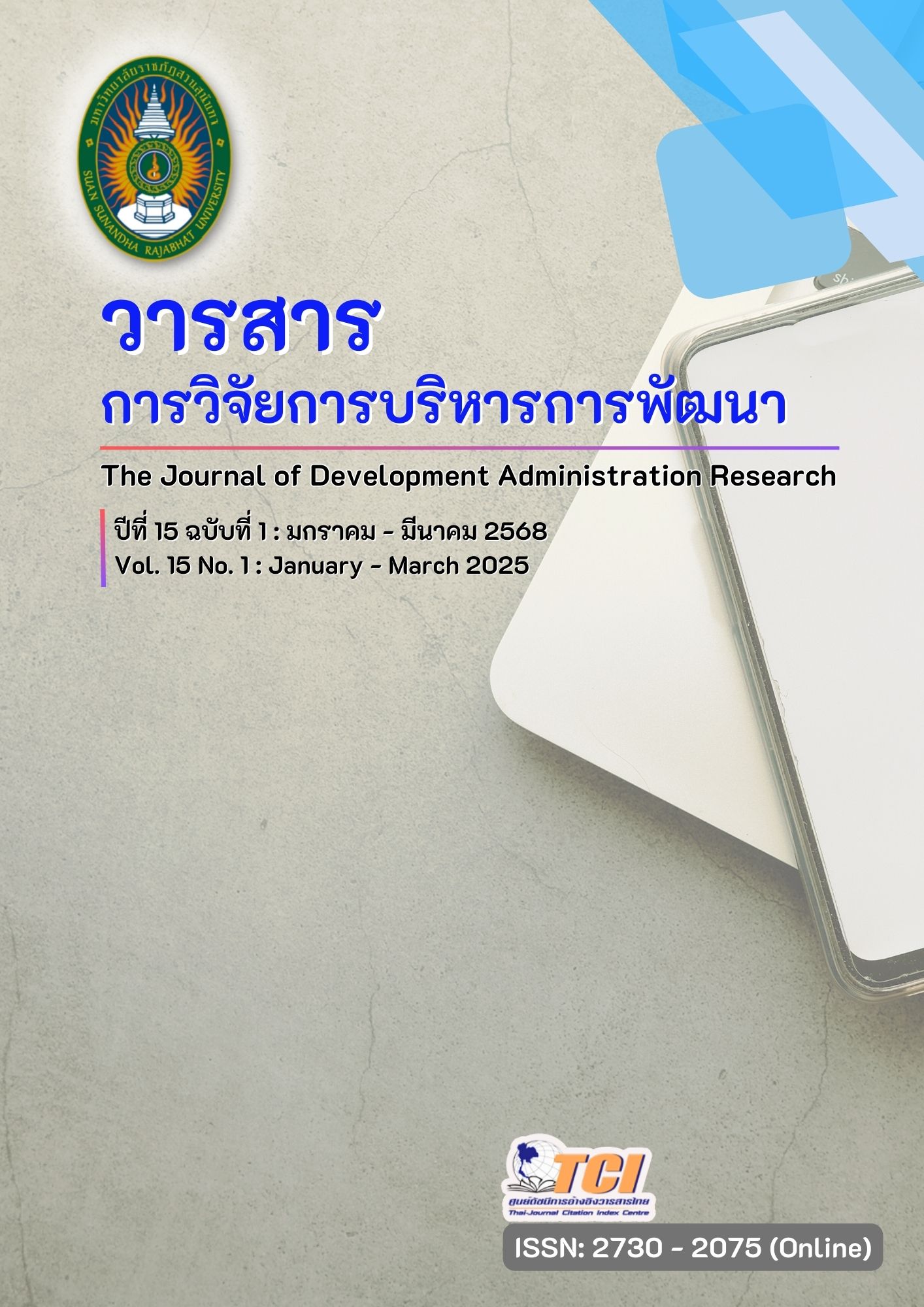ปัจจัยเชิงสาเหตุของการตลาดเจนเนอเรชั่นสำหรับสื่อสังคม ที่ส่งผลต่อการมีส่วนร่วมของลูกค้าในธุรกิจค้าปลีกสมัยใหม่
คำสำคัญ:
การตลาดเจนเนอเรชั่น, สื่อสังคม, ออนไลน์สู่ร้านค้า, การมีส่วนร่วมของลูกค้าบทคัดย่อ
บทความวิจัยนี้มีวัตถุประสงค์เพื่อ 1) ศึกษาปัจจัยเชิงสาเหตุที่ส่งผลต่อการตลาดเจนเนอเรชั่นสำหรับสื่อสังคมและการมีส่วนร่วมของลูกค้า 2) ศึกษาอิทธิพลของปัจจัยเชิงสาเหตุของการตลาดเจนเนอเรชั่นสำหรับ
สื่อสังคมที่ส่งผลต่อการมีส่วนร่วมของลูกค้าในธุรกิจค้าปลีกสมัยใหม่ และ 3) สร้างแบบจำลองของปัจจัยเชิงสาเหตุของการตลาดเจนเนอเรชั่นสำหรับสื่อสังคมที่ส่งผลต่อการมีส่วนร่วมของลูกค้า ใช้วิธีวิจัยเชิงปริมาณ เครื่องมือที่ใช้เก็บรวบรวมข้อมูล ได้แก่ แบบสอบถามออนไลน์ สถิติที่ใช้ในการวิเคราะห์ข้อมูล ได้แก่ สถิติเชิงพรรณนาและสถิติเชิงอนุมาน และ สถิติโมเดลสมการโครงสร้าง (Structural Equation Modelling)
ผลการวิจัยพบว่า 1) ปัจจัยเชิงสาเหตุด้านห่วงโซ่อุปทานของตลาดส่งผลต่อการตลาดเจนเนอเรชั่นสำหรับสื่อสังคม และห่วงโซ่อุปทานของตลาดส่งผลต่อการมีส่วนร่วมของลูกค้าผ่านการตลาดเจนเนอเรชั่นสำหรับสื่อสังคม 2) อิทธิพลของปัจจัยเชิงสาเหตุได้แก่ การแบ่งกลุ่มลูกค้าออนไลน์ส่งผลต่อการตลาดเจนเนอเรชั่นสำหรับสื่อสังคม การแบ่งกลุ่มลูกค้าออนไลน์ส่งผลต่อการมีส่วนร่วมของลูกค้าผ่านการตลาดเจนเนอเรชั่นสำหรับสื่อสังคม ช่องทางออนไลน์สู่ร้านค้าส่งผลต่อการตลาดเจนเนอเรชั่นสำหรับสื่อสังคม ช่องทางออนไลน์สู่ร้านค้าส่งผลต่อการมีส่วนร่วมของลูกค้าผ่านการตลาดเจนเนอเรชั่นสำหรับสื่อสังคม และการตลาดเจนเนอเรชั่นสำหรับสื่อสังคมส่งผลต่อการมีส่วนร่วมของลูกค้า 3) แบบจำลองสำหรับธุรกิจค้าปลีกสมัยใหม่คือการนำปัจจัยจากผลการศึกษาวิจัยมากกำหนดแนวทางการพัฒนาระบบการซื้อสินค้าออนไลน์ของผู้บริโภคอัน ทส่งผลให้การบริหารการตลาดเจนเนอเรชั่นสำหรับสื่อสังคม และทำให้ผู้บริโภคมีส่วนร่วมของลูกค้ามากขึ้น
เอกสารอ้างอิง
Aslam, H., Waseem, M., Muneeb, D., & Ali, Z. (2023). Customer integration in the supply chain: the role of market orientation and supply chain strategy in the age of digital revolution. Annals of Operations Research.
Chang, C. W., & Hsu, C. P. (2022). How to generate customer and firm benefits through online game product and brand community engagement – online and offline perspectives. Journal of Product & Brand Management, 31(8). DOI:10.1108/JPBM-04-2021-3448
Golgeci, I., & Kuivalainen, O. (2019). Does social capital matter for supply chain resilience? The role of absorptive capacity and marketing-supply chain management alignment. Industrial Marketing Management.
Haikal, E.K., Freihat, S., Moh, D. & Homsi, A. (2020). The Role of Supply Chain Strategy and Affiliate Marketing in Increasing the Demand for E- Commerce -Social Media POV. International Jounal of Supply Chain Management, 9(1), 832-844.
Hair, J., Black, W., Babin, B., Anderson, R. and Tatham, R. (2006) Multivariate data analysis. 6th Edition, Pearson Prentice Hall, Upper Saddle River.
Rane, N., Achari, A., & Choudhary, S. (2023). Enhancing customer loyalty through quality of service: Effective strategies to improve customer satisfaction, experience, relationship,and engagement.
Reddy, K. S., & Azeem, B. A. (2022, March). Impact of social media marketing on online impulse buying behaviour.
Rombe, E., & Hadi, S. (2022). The impact of supply chain capability and supply chain performance on marketing performance of retail sectors. Uncertain Supply Chain Management, 10(2), 593-600.
Sarkum, S. (2018, December). Supply chain involvement in engagement verification of marketing and operational collaboration.
Suh, T., & Lee, S. B. (2023). Configuring managerial factors to enhance omnichannel experience and customer engagement behaviors for a solid loyalty loop. Electronic Commerce Research.
Trivedi, N., Asamoah, D. A., & Doran, D. (2018). Keep the conversations going: engagement-based customer segmentation on online social service platforms. Information Systems Frontiers, 20(2), 239-257.
Wang, X., & Ramasamy, G. A. (2023, February). Digital marketing in the perspective of omnichannel retailing for customer engagement [Conference session]. Proceedings of the 2nd International Conference on Emerging Technologies and Intelligent Systems, (pp.122-131).
Wiedenroth, C. F., & Otter, V. (2022). Can new healthy luxury food products accelerate short food supply chain formation via social media marketing in high-income countries? Agricultural and Food Economics, 10(1). https://doi.org/10.1186/s40100-022-00238-3
Yürük-Kayapınar (2022). Examination of empirical studies on customer engagement, online engagement, and social media engagement. Research Anthology on Social Media Advertising and Building Consumer Relationships, 238-256.
Zhu, W. (2023). Research on the impact ofmulti-channel integration quality on customers’ engagement behavior. Frontiers in Business, Economics and Management, 7(2). https://doi.org/10.54097/fbem.v7i2.4892
ดาวน์โหลด
เผยแพร่แล้ว
รูปแบบการอ้างอิง
ฉบับ
ประเภทบทความ
สัญญาอนุญาต
ลิขสิทธิ์ (c) 2025 วารสารการวิจัยการบริหารการพัฒนา

อนุญาตภายใต้เงื่อนไข Creative Commons Attribution-NonCommercial-NoDerivatives 4.0 International License.
บทความที่ได้รับการตีพิมพ์เป็นลิขสิทธิ์ของมหาวิทยาลัยราชภัฏสวนสุนันทา
ข้อความที่ปรากฏในบทความแต่ละเรื่องในวารสารวิชาการเล่มนี้เป็นความคิดเห็นส่วนตัวของผู้เขียนแต่ละท่านไม่เกี่ยวข้องกับมหาวิทยาลัยราชภัฏสวนสุนันทา และคณาจารย์ท่านอื่นๆ ในมหาวิทยาลัยฯ แต่อย่างใด ความรับผิดชอบองค์ประกอบทั้งหมดของบทความแต่ละเรื่องเป็นของผู้เขียนแต่ละท่าน หากมีความผิดพลาดใดๆ ผู้เขียนแต่ละท่านจะรับผิดชอบบทความของตนเองแต่ผู้เดียว




